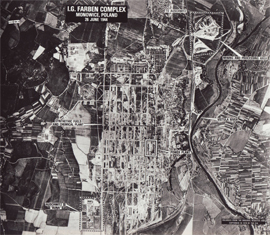Airstrikes on Auschwitz

26 June 1944”
U.S. aerial reconnaissance photo
© National Archives, Washington, DC
The first airstrike on I.G. Auschwitz carried out by several Allied aircraft took place during the night of May 4, 1943. One watchtower at the Buna/Monowitz concentration camp came under machine-gun fire, and nine bombs fell near the prisoners’ camp without causing any damage. This strike probably was the work of the Red Army’s air force, as the range of the British and American bomber wings in 1943 did not yet extend as far as Auschwitz. After their landing in southern Italy and capture of the military airfield at Foggia in December 1943, the Western Allies had the capability to reach targets in Hungary, Romania, Slovakia, southern Poland, and Upper Silesia.
The I.G. Farben plant at Auschwitz-Monowitz was first photographed on an American reconnaissance flight on April 4, 1944. When analyzing the aerial photos, Royal Air Force specialists identified various production facilities of I.G. Auschwitz as targets for strategic aerial warfare. Additional recon flights followed between late May and mid-August 1944. The first sizable bombing raid by the 15thU.S. Army Air Force on the plant buildings of I.G. Auschwitz took place on August 20, 1944. Because of the heavy escort of 100 P-51 Mustang fighters, only one of the 127 bombers employed was shot down. The attack inflicted considerable damage on the production facilities of I.G. Auschwitz. Monowitz prisoner Adam Szaller managed to escape during the strike. According to the testimony of Monowitz prisoner Siegfried Pinkus, “around 75 prisoners were killed” in this raid, and “more than 150 prisoners were injured, some only slightly, others seriously.”[1] Pinkus held the plant managers of I.G. Auschwitz jointly responsible for this, because they had forbidden prisoners to take cover in self-made shelters. Though their lives were at risk, many prisoners welcomed the Allied air raids because they terrified the SS guards, reduced the capacities of German war production, and brought the hoped-for liberation closer.
On September 13, 1944, an attack flown by 96 B-24 Liberator bombers heavily damaged the I.G. Auschwitz construction site. The main camp and the Auschwitz II camp (Birkenau) were hit. In this airstrike, an estimated total of 300 people, including SS men, were injured and killed. A further air raid on December 18, 1944, heavily damaged the pump and compressor stations of I.G. Auschwitz. As an Allied assessment report mentions, five barracks of the concentration camp also suffered damage in the strike. The fourth airstrike on I.G. Auschwitz, on December 26, 1944, was rated a success by Allied aerial reconnaisance because of the serious damage done to the plant. The last attack by the U.S. Air Force took place on January 19, 1945, one day after the start of the evacuation of the camp complex, when the SS forced the prisoners to begin a westward death march.
In the United States and Great Britain, there has been a controversy since the late 1970s over the reasons why the Allied air forces did not destroy the extermination facilities or the railroad tracks on which the deportation trains rolled into Auschwitz, in order to slow the pace of the mass murder.
(FS; transl. KL)
















